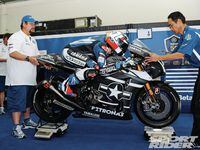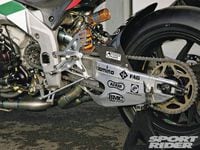When setting a bike up for roadracing track work is there any rationale for scaling the bike wheel weights with the rider on, similar to what one would do with a racing car?
Rex Svoboda
Missoula MT
_As you can see from the picture, static weight bias with the rider aboard is very critical at the MotoGP level. For most sportbike riders and club-level racers, however, it’s very difficult to change static weight bias (as measured when the bike is stationary) and more important to consider what’s happening when the bike is on the road or track — dynamic weight bias. A common misconception is that raising or lowering the front or rear of a bike changes weight bias; many racers refer to raising the fork tubes in the triple clamps as “putting more weight on the front end.” But in fact, changing ride height a few millimeters has little effect, shifting a few pounds at most even with a larger change. To significantly adjust weight bias you would have to move something big and heavy — like the engine, fuel tank or rider — forward or rearward. Another option is to move almost the whole bike relative to the wheels, by shortening or lengthening the swingarm or changing rake to move the front wheel in or out. Of these options, the easiest is to move the rider around using different clip-ons, rearsets and modifying the seat — still not easy modifications.
When things are in motion, a bike is very different from a car in terms of weight bias. The motorcycle rider can make a change just by sitting up or leaning forward, whereas the car driver is strapped in and not moving. A motorcycle pitches fore and aft on six inches of suspension and that amount of movement over a short wheelbase transfers a lot of weight, whereas a racing car has a longer wheelbase and typically much less suspension travel; relatively less weight is transferred as the car moves on its suspension. What you measure in the pits for weight bias on a car is fairly representative of what’s happening on the track; on a motorcycle, however, it’s just a starting point and many more variables must be considered.
_Dynamic weight bias on a motorcycle is affected by anything that affects where the suspension is in its stroke at a given moment. Spring rates and the rear suspension linkage are the big contributors here, but there's also how the rider moves around on the bike. And on a more powerful bike anti-squat must be taking into account; swingarm pivot height, gearing, swingarm length and angle all play a part. We oftentimes measure static weight bias on various bikes for comparison purposes, and it's helpful for a baseline to keep track of any changes as modifications are made. But it doesn't provide the whole picture as far as how that weight bias affects performance on the track. _SR_



/cloudfront-us-east-1.images.arcpublishing.com/octane/ZN44KZLHD5CHVIY3WZYAGTPGSI.jpg)
/cloudfront-us-east-1.images.arcpublishing.com/octane/5A776WXBY5GAPDYFTTUEUZNIJA.jpg)
/cloudfront-us-east-1.images.arcpublishing.com/octane/NCYHFQ2S3BAT7EC7VDN2ONGRTU.jpg)
/cloudfront-us-east-1.images.arcpublishing.com/octane/XQORS527YFFT3MVI326EOEYJUI.jpg)
/cloudfront-us-east-1.images.arcpublishing.com/octane/TVDPP3TGMZHODFXASIFUM2KD34.jpg)
/cloudfront-us-east-1.images.arcpublishing.com/octane/EWDMR3DDTBBQPI7DQVZCLMRFAE.jpg)
/cloudfront-us-east-1.images.arcpublishing.com/octane/4XHHLVOUKFE3PDSWNSV4JJMGOE.jpg)
/cloudfront-us-east-1.images.arcpublishing.com/octane/5RLI3NQKQJA3LKKCQHRXQFTL6Q.jpg)
/cloudfront-us-east-1.images.arcpublishing.com/octane/3QCYJCI2RNBENIRWAKEOEKHFUM.jpg)
/cloudfront-us-east-1.images.arcpublishing.com/octane/XJFFFMRN6VEZ7CDNAGKWVPC3H4.jpg)
/cloudfront-us-east-1.images.arcpublishing.com/octane/RMC3CHWSHFAUJA2WJ2FVG4NBOA.jpg)
/cloudfront-us-east-1.images.arcpublishing.com/octane/WXEZV4WAYBERFKSRE5M7GQBW7A.jpg)
/cloudfront-us-east-1.images.arcpublishing.com/octane/LO3PZVGICFGJZBNUA2ORUSAUSE.jpg)
/cloudfront-us-east-1.images.arcpublishing.com/octane/UFHLTNOXLVARVLZV32M6ZJZV4Y.jpg)
/cloudfront-us-east-1.images.arcpublishing.com/octane/CTSWNU7SNNCC3LWB2KATYZ5AXY.jpg)
/cloudfront-us-east-1.images.arcpublishing.com/octane/72EPJVNA2VGVXJ2BVDFFLN67KQ.jpg)
/cloudfront-us-east-1.images.arcpublishing.com/octane/A7C4GNXEHNHC3LL6RETG6MIPPY.jpg)
/cloudfront-us-east-1.images.arcpublishing.com/octane/Q4KZ7ACKF5BVTE56LMG7RPJCEM.jpg)
/cloudfront-us-east-1.images.arcpublishing.com/octane/RQ2CXG6ATJBUZGUR7NP35C3VBE.jpg)
/cloudfront-us-east-1.images.arcpublishing.com/octane/MWSEWNFALBBJHOQGZTUUPVOQOU.jpg)
/cloudfront-us-east-1.images.arcpublishing.com/octane/LTPXG4ZHCVFNDNILFQ6PN6YUKI.jpg)
/cloudfront-us-east-1.images.arcpublishing.com/octane/EAEWHFARGVGHFH4N4BDOSNBJSU.jpg)
/cloudfront-us-east-1.images.arcpublishing.com/octane/AZ7H35TQSZDKZCVM4S6CHERQEU.jpg)
/cloudfront-us-east-1.images.arcpublishing.com/octane/GYMIU7SMN5CWHP6QLFR6MVKEBU.jpg)